Are you ready to transform your garden without breaking the bank? You don’t need a big budget to make big changes in your outdoor space.
With a few clever ideas and some creativity, you can make your garden a place you love without spending a fortune.
Get ready to discover 15 ways to revamp and enjoy your garden on a budget.
By utilizing these budget-friendly tips, you’ll find that enhancing your garden can be both fun and affordable.
Save This Pin on your Pinterest Board:
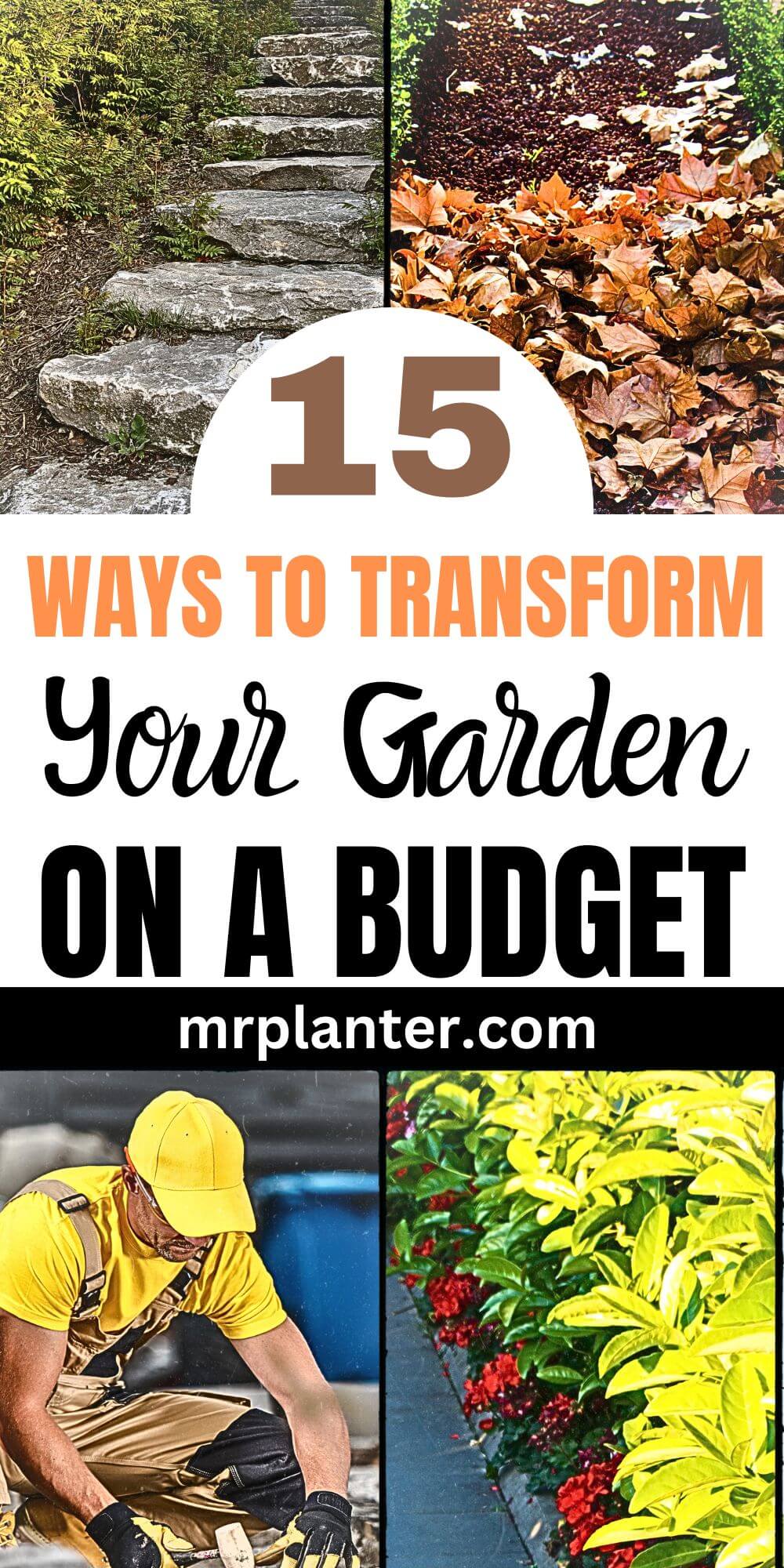
1. Create a Focal Point
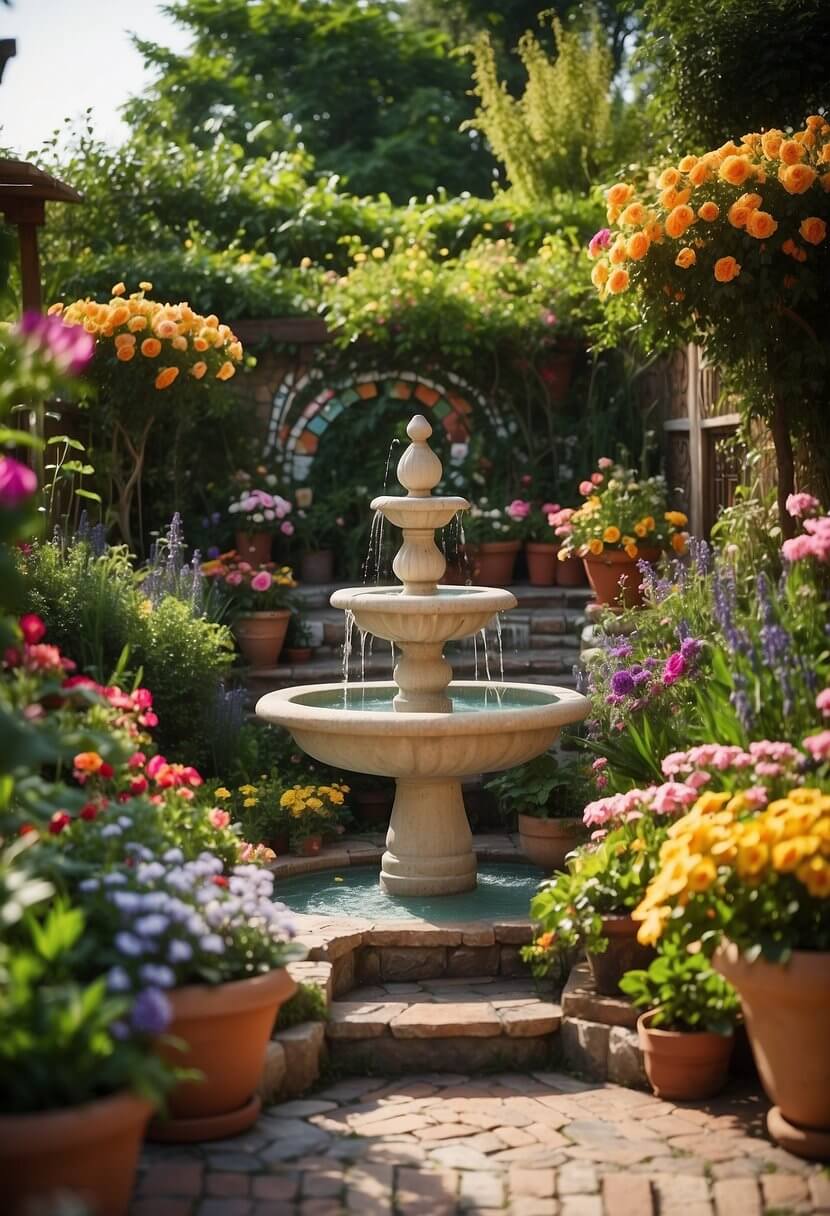
Creating a focal point in your garden is simple and affordable. By drawing the eye to one main feature, you can make your garden look more polished.
Water features like fountains or bird baths are great choices. You don’t need to spend a lot; DIY options work just as well. The gentle sound of water can also add a relaxing atmosphere.
You can also use plants to create a central point. A tall tree, a cluster of colorful flowers, or even a large potted plant can do the trick. Pick something that stands out and draws attention.
Statues or garden ornaments are another way to add interest. Find something that fits your garden’s style, whether it’s modern, classic, or whimsical. You might even discover some treasures at thrift shops or garage sales.
Fairy lights can turn even the simplest spot into a magical focal point. String them around a tree, patio umbrella, or along a fence. They are cheap and easy to install, providing immediate charm and warmth.
Use paint to highlight fences, pots, or old furniture. Bright colors can make elements pop, creating an eye-catching feature without a big expense.
2. Use Recycled Materials
Using recycled materials in your garden is a smart way to save money and reduce waste. You can turn old items into wonderful garden decorations and helpful tools.
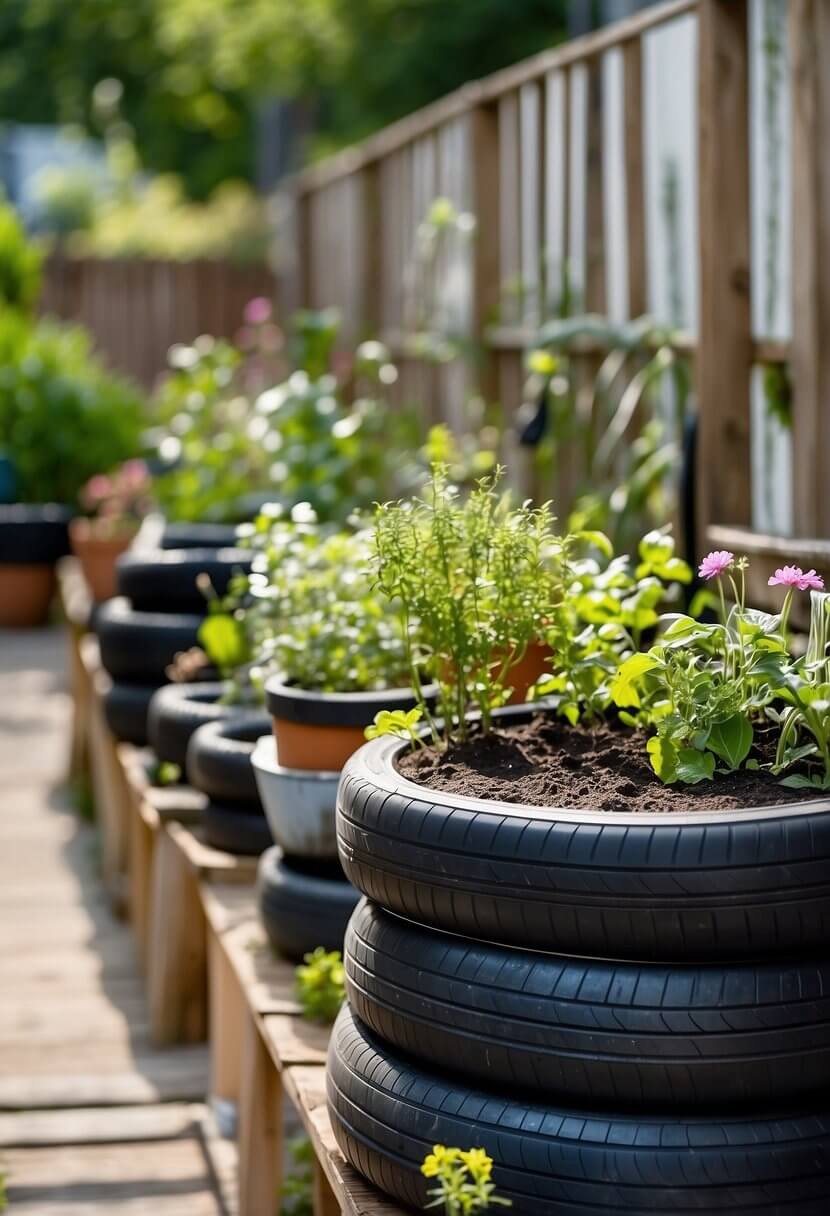
1. Old Boot Planters
Take those old boots you no longer wear and turn them into unique planters. Just fill them with soil and your favorite plants, then place them around your garden.
2. Upcycled Kitchenware
Got old teapots, colanders, or pots? Use them as planters. They add a quirky touch to your garden and give your old kitchenware a new life.
3. Window Frame Greenhouses
Build a small greenhouse using old window frames. It’s perfect for starting seedlings and protecting plants from the weather. Plus, it’s a great way to recycle materials.
4. Tire Planters
Paint old tires in bright colors and use them as planters or even garden borders. They add a pop of color and are durable enough for the outdoors.
5. Jeans Planters
Old jeans can also be turned into fun planters. Fill the legs with soil and plants and hang them over garden fences or railings for a playful look.
6. Recycled Glass Bottles
Arrange glass bottles as garden edging or stack them to create colorful garden walls. They add a creative flair and put glass waste to good use.
7. Tree Stump Planters
Turn old tree stumps into planters. Just hollow out a space and fill it with soil and plants. It gives a rustic feel and makes use of an otherwise tricky spot in your garden.
By using recycled materials, you can make your garden look fantastic without breaking the bank. Plus, it’s a fun way to get creative and help the environment at the same time.
3. DIY Garden Furniture
Freshen up your garden by making your own furniture. You can make your outdoor space cozy and inviting without spending a lot of money.
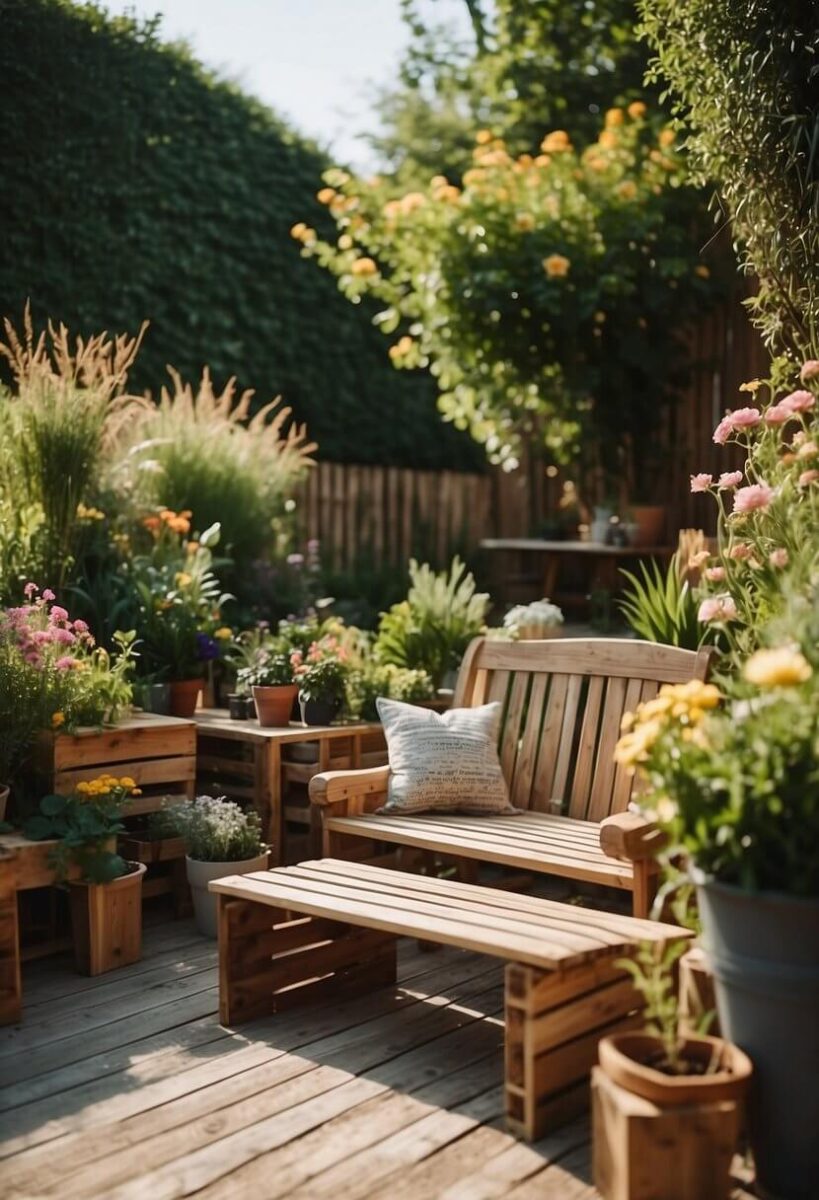
1. Pallet Furniture: Pallets are versatile and easy to find. Use them to make sofas, tables, or even planters. Just add some cushions for comfort.
2. Painted Furniture: Give old chairs or tables a new life with a fresh coat of weather-resistant paint. Bold colors can add a pop to your garden.
3. Cinder Block Benches: Stack cinder blocks and place wooden beams on top to create sturdy benches. You can paint the blocks to match your garden’s theme.
4. Tire Chairs: Paint old tires and stack them to the desired height. Add a cushion on top, and you’ve got a funky and unique chair.
5. Tree Stump Seats: Use tree stumps as natural seating. Sand them down and maybe add a coat of varnish. They bring a rustic vibe to your garden.
6. Thrift Store Finds: Visit your local thrift store. You might find affordable pieces that only need a bit of TLC to fit perfectly in your garden.
7. Upcycled Plant Stands: Turn an old ladder into a plant stand. Paint it and use its steps to display your potted plants beautifully.
Making your own garden furniture can be fun and economical. Plus, it gives your garden a personal touch!
4. Add Beautiful Lighting
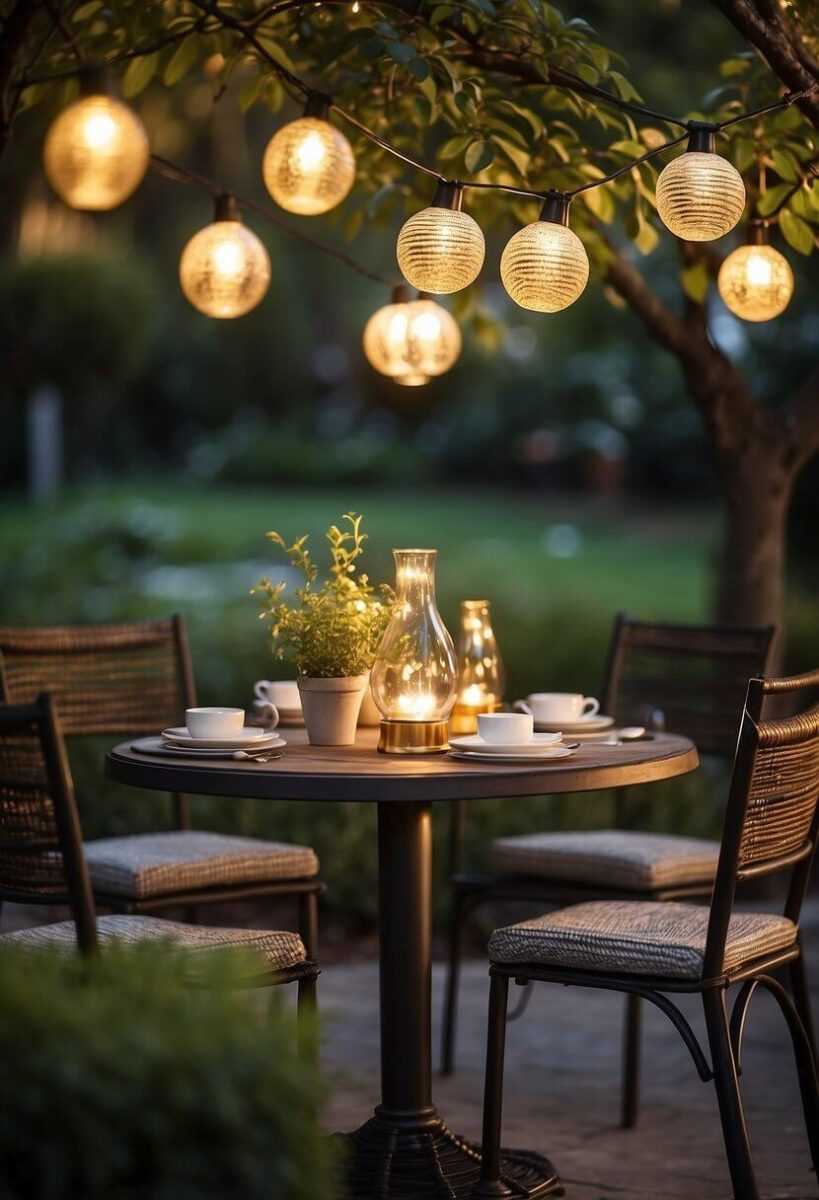
Adding lighting to your garden can make it more inviting and enjoyable, especially in the evenings.
You can use solar lights along pathways for a simple and budget-friendly option. They charge during the day and automatically illuminate at night.
String lights are another great choice. Hang them on trees, fences, or pergolas to create a cozy atmosphere.
Consider using lanterns for a charming, rustic touch. Place them on tables or hang them from branches.
Globe-shaped lights can provide a unique look. They work well in gravel gardens or behind plants to highlight their beauty.
For a more dramatic effect, use spike spotlights to uplight trees and hedges.
Waterproof LED tape lights along the edges of your patio or deck can add an elegant touch and improve safety.
Adding lighting doesn’t have to be expensive. There are many affordable and creative ways to brighten up your garden.
5. Grow from Seeds
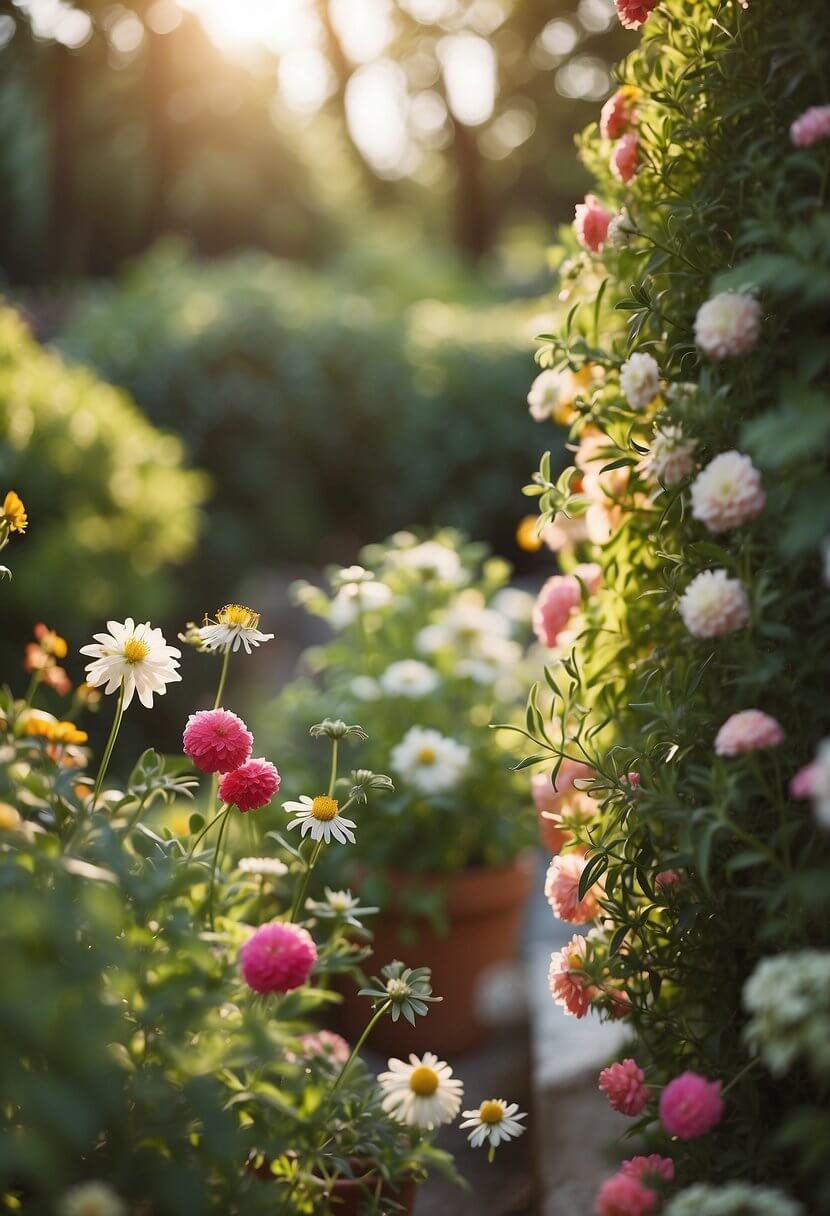
Growing plants from seeds is a fantastic way to save money in your garden. Seeds are much cheaper than buying young plants or seedlings.
You can start seeds indoors in small containers like egg cartons or yogurt cups. Just poke a few holes for drainage, fill with soil, and plant the seeds according to the packet instructions.
Another tip is to reuse items like toilet paper rolls or newspaper pots to start your seeds. These can be planted directly into the ground, making transplanting easier and reducing waste.
Keep the soil moist and place the containers in a sunny window or under a grow light. Once the seedlings have a few sets of true leaves, they are ready to be transplanted into your garden.
By growing from seeds, you also have access to a wider variety of plants. Seed catalogs offer many unique and rare varieties that you might not find at your local nursery.
Here’s a quick list of easy-to-grow plants from seeds:
- Tomatoes
- Basil
- Lettuce
- Marigolds
Starting seeds at home not only saves money but also gives you a great sense of accomplishment. Plus, it’s a fun project for the whole family!
6. Mulching

Mulching is a great way to improve your garden without spending a lot of money. Mulch helps retain moisture in the soil, which means you don’t have to water your plants as often.
You can use a variety of materials for mulch. Wood chips, leaves, straw, and grass clippings all work well and are often available for free.
Mulch also helps keep weeds down. Weeds compete with your plants for nutrients, so less weeding means healthier plants.
Adding mulch to your garden can also make it look more polished and neat. A rich layer of mulch around your flower beds or trees adds a nice contrast and helps define spaces.
Tip: Remember to leave a bit of space around the base of plants when you mulch. This helps prevent rot and allows air to reach the roots.
7. Vertical Gardening
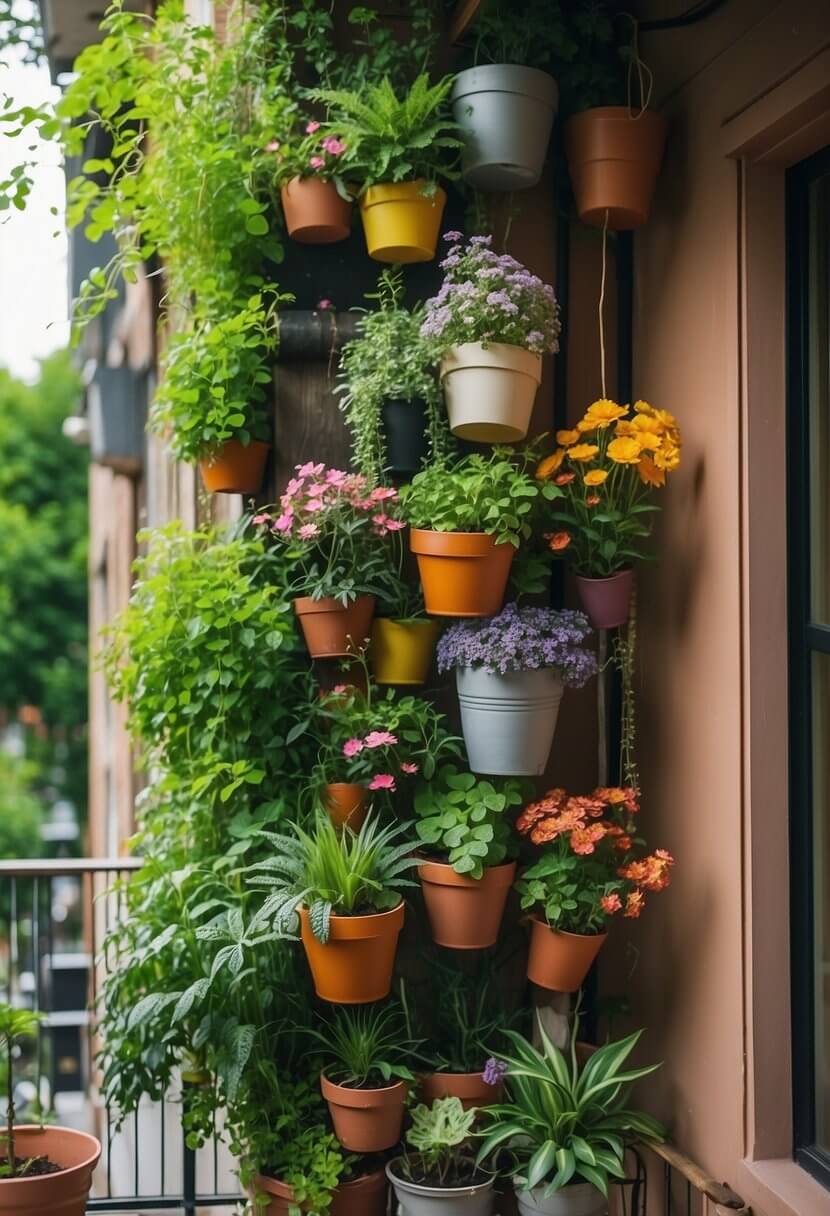
Vertical gardening is a great way to save space, especially if you have a small yard. Instead of spreading your plants horizontally, you grow them upwards. This approach can make your garden more efficient and visually appealing.
One benefit of vertical gardening is easier harvesting. When your plants are elevated, you don’t have to bend down. This can reduce strain on your back and knees.
Making a strawberry tower garden is one simple project. It’s an easy way to use up leftover materials from your garage. You can place it in your garden or on your patio.
Vertical gardening can also protect plants from rot and pests. Keeping plants off the ground helps prevent them from sitting in water and getting diseases.
You don’t need a lot of space for vertical gardening. The Garden Tower is an example of a compact system that only needs four square feet but can hold up to 50 different plants.
Quick Ideas for Vertical Gardening:
- Use old pallets as plant racks.
- Hang pots on a wall.
- Create a trellis with wires and poles.
By using vertical space, you can make your garden more productive and easier to manage.
8. Paint and Refresh

A fresh coat of paint can do wonders for your garden.
Start with your fences. Pick a weatherproof exterior paint to brighten them up. Choose colors that complement your plants.
Next, look at your garden furniture. If it looks worn out, a quick paint job can make it look brand new.
Use spray paint for a smooth finish on metal or plastic furniture. For wooden pieces, use a brush for better coverage.
Don’t forget about your plant pots. You can paint them in bold colors or patterns to add some flair to your garden.
Consider adding a mural to a blank garden wall. It adds personality and becomes a focal point.
Refresh your decking or patio by giving it a thorough clean, then repainting it. Use a pressure washer before painting for the best results.
Brighten up any dull areas with painted garden accessories like birdhouses, trellises, or even a unique garden gnome.
Experiment with different colors and have fun transforming your garden space!
9. Create a Pathway
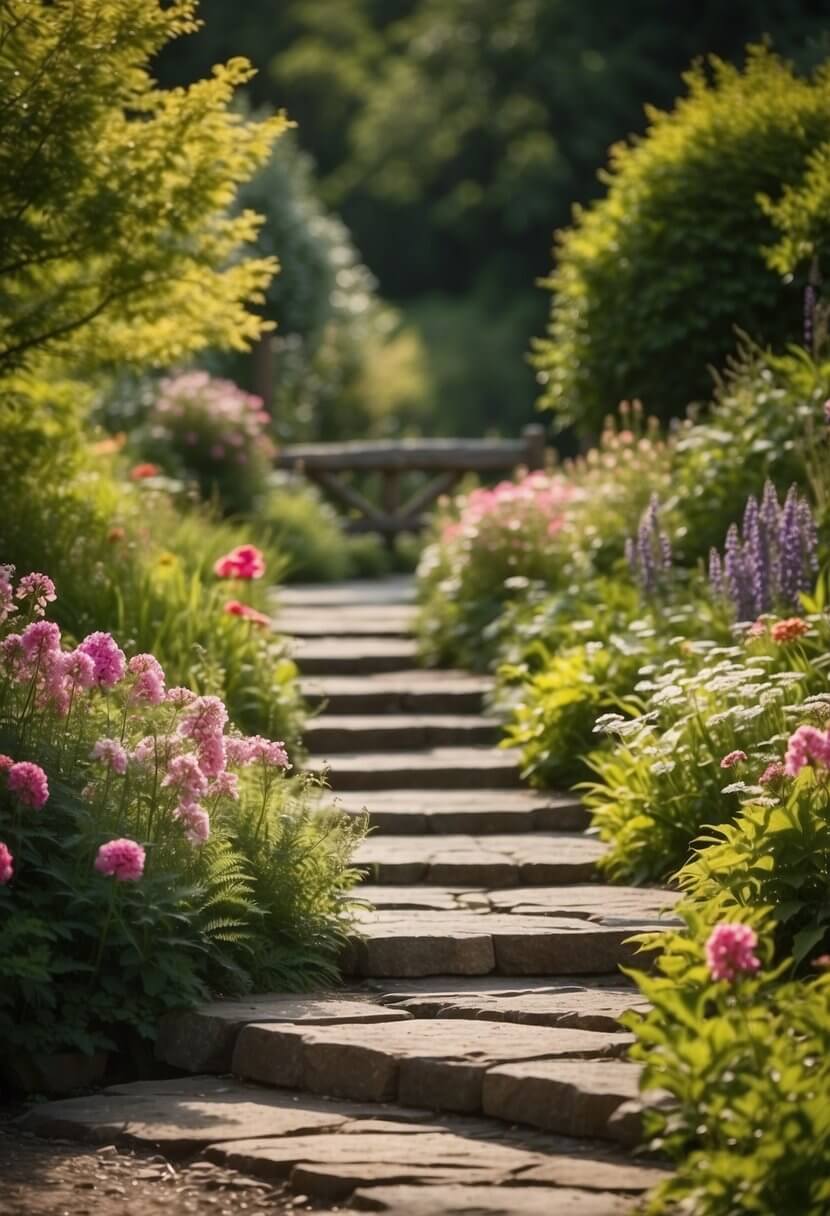
Adding a pathway to your garden can be both functional and beautiful.
Materials:
- Pea Gravel: Cost-effective at $1 to $3.15 per square foot.
- Wood Chips: Natural and budget-friendly.
- Pavers and Bricks: More expensive, but durable.
Steps:
- Plan the Path: Map out where you want your path to go. Consider the layout of your garden and how you move through the space.
- Prepare the Ground: Clear the area of grass and weeds. Level the ground so your materials can lay flat.
- Install Edging: Edging helps keep your path materials in place. You can use plastic, metal, or wood.
- Lay Down a Base: A base layer like landscape fabric can prevent weeds. For gravel or wood chips, add a layer of sand.
- Add Your Material: Spread your chosen material over the base. Smooth it out evenly.
Tips:
- Mix Materials: Combine different materials for a unique look.
- Lighting: Add solar lights along the path for nighttime use.
- Landscaping: Plant flowers or shrubs along the edges to enhance the path.
Creating a pathway doesn’t have to be expensive. By choosing affordable materials and planning carefully, you can add charm and functionality to your garden on a budget.
10. Composting

Composting is a great way to enrich your garden soil while reducing kitchen and yard waste. You can either build a compost bin from wooden pallets or repurpose an old garbage bin. Place it in a spot that gets some sunlight.
To get started, gather “green” and “brown” materials. Greens include kitchen scraps like fruit peels and vegetable leftovers. Browns include items like dry leaves, cardboard, and newspaper.
Layer these materials in the bin, aiming for about 3-4 times more browns than greens. This helps balance the compost and speeds up the breakdown process. Keep the pile moist, but not too wet. Think of a damp sponge as your moisture guide.
Using compost in your garden is quite simple. Once it’s ready, you can spread it about 2-3 inches deep over your garden. Just keep it about an inch away from the stems of your plants to avoid damage.
If you live in an area with chlorinated water, try using rainwater or let tap water sit for 24 hours before using it. This helps protect beneficial microorganisms in the compost.
11. Water Features
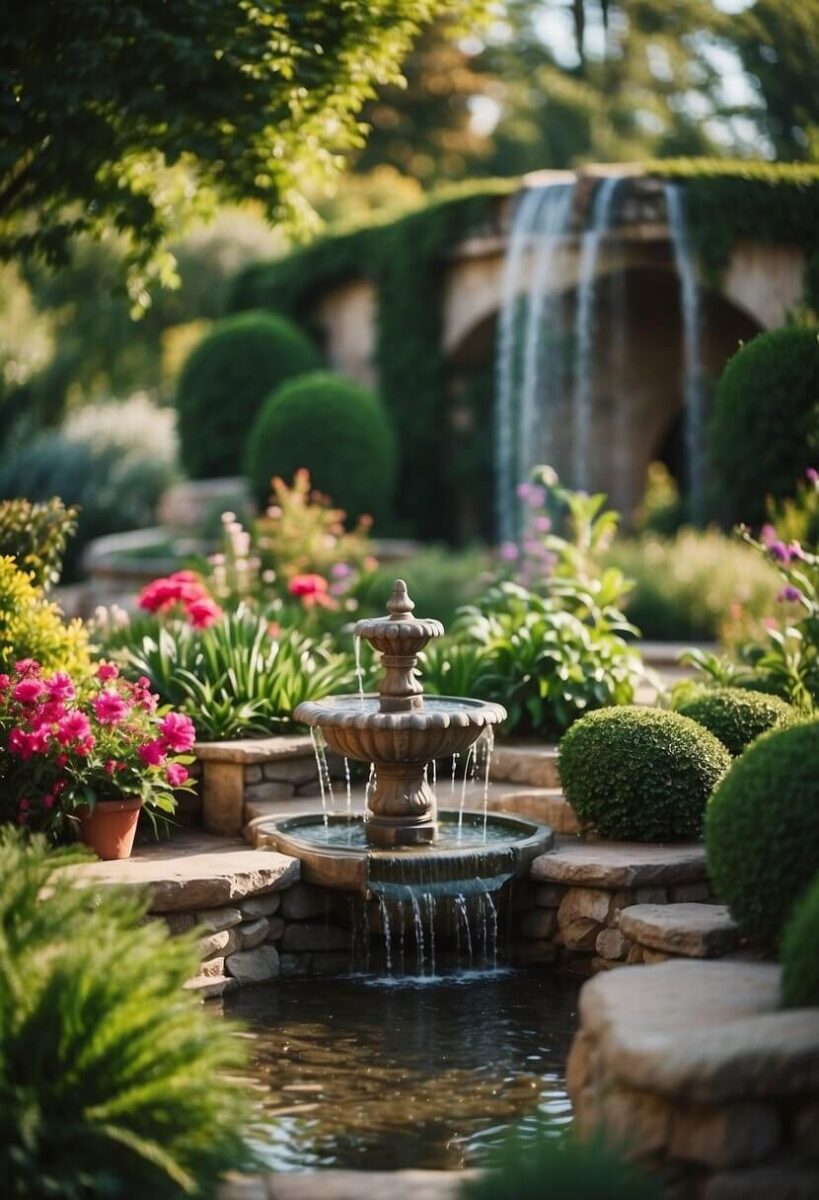
Adding a water feature to your garden can create a beautiful and calming atmosphere. It’s easier than you might think, and there are options for every budget.
1. Bird Bath: A simple bird bath can attract local birds, adding life to your garden. You can find inexpensive options at garden centers or even make your own.
2. Small Fountain: Buy a small, solar-powered fountain. These are easy to set up and don’t require wiring. They add the soothing sound of moving water.
3. Reflecting Pool: Use a shallow container to create a reflecting pool. Fill it with water and place it in a sunny spot. The reflections will add depth and beauty to your space.
4. Koi Pond: If you have more space and budget, consider adding a koi pond. They bring an element of tranquility and can be a focal point in your garden.
5. DIY Pond: Create your own small pond. Dig a hole, line it with a pond liner, and fill it with water. Add some aquatic plants to make it more natural.
6. Waterfall: A small DIY waterfall can be as simple as stacking rocks and adding a pump. The cascade of water is relaxing and visually appealing.
7. Modern Garden Pool: A sleek, narrow pool made from concrete or stone can give your garden a modern look. Line it with plants for a striking effect.
Use these ideas to add a water feature that fits your style and budget. Your garden can become a peaceful retreat with the right water element in place.
12. Plant Perennials
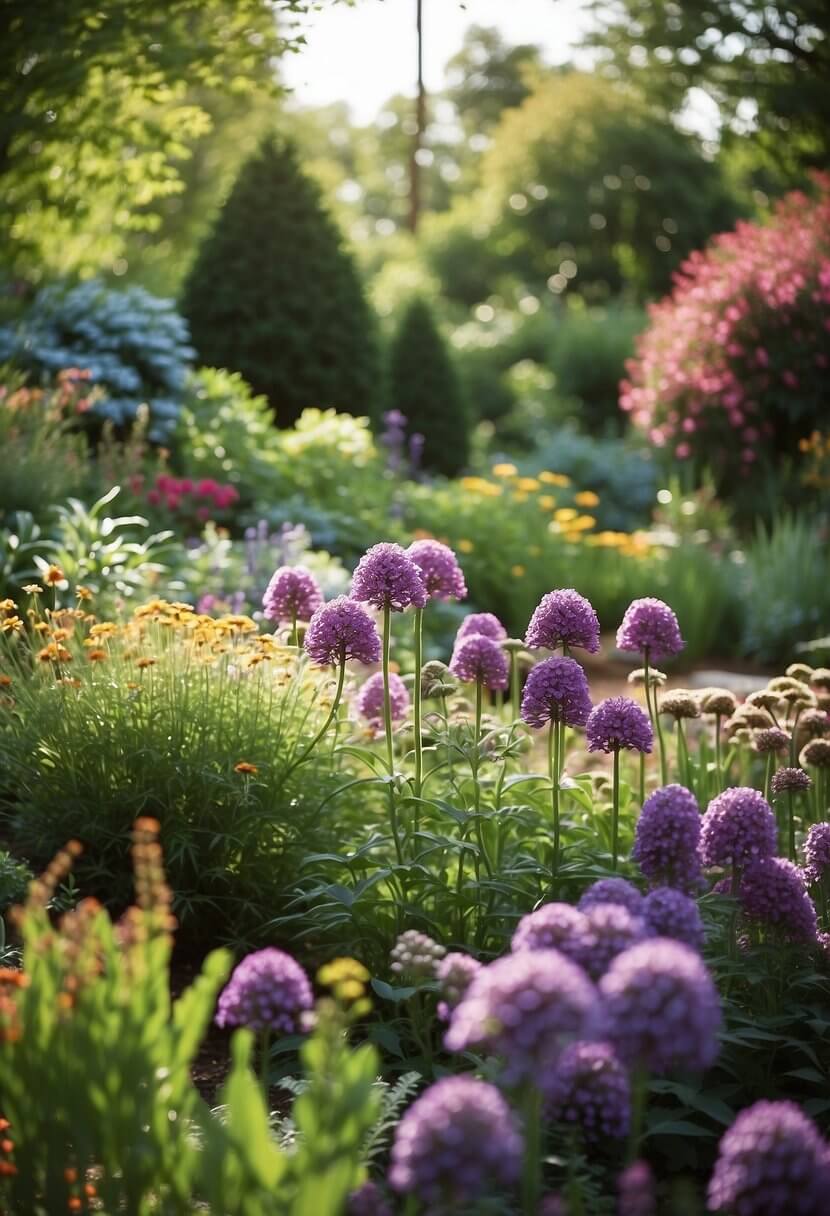
Perennials are a great way to keep your garden looking beautiful without spending a lot of money each year. These plants come back every year, saving you the cost and effort of replanting.
Here are a few low-maintenance perennials you should consider:
- Chives: These have thin, green leaves and purple flowers. Perfect for zone 4-8.
- Hostas: Great for shady areas, offering lush foliage.
- Daylilies: These require little care and bloom in zones 3-9.
Benefits:
- Cost-effective: You buy them once, and they keep coming back.
- Low-maintenance: They need less care compared to annuals.
- Soil improvement: Many perennials improve soil health over time.
Consider splitting your perennials every few years. This not only helps the plants grow better but also gives you more plants for free!
Planting in groups can also make your garden look fuller and more attractive without spending too much. You’ll have a beautiful, full garden without the high cost.
Lastly, perennials can often be found for free in plant swaps or from friends’ gardens. Keep an eye out for these opportunities to save even more.
13. Outdoor Cinema
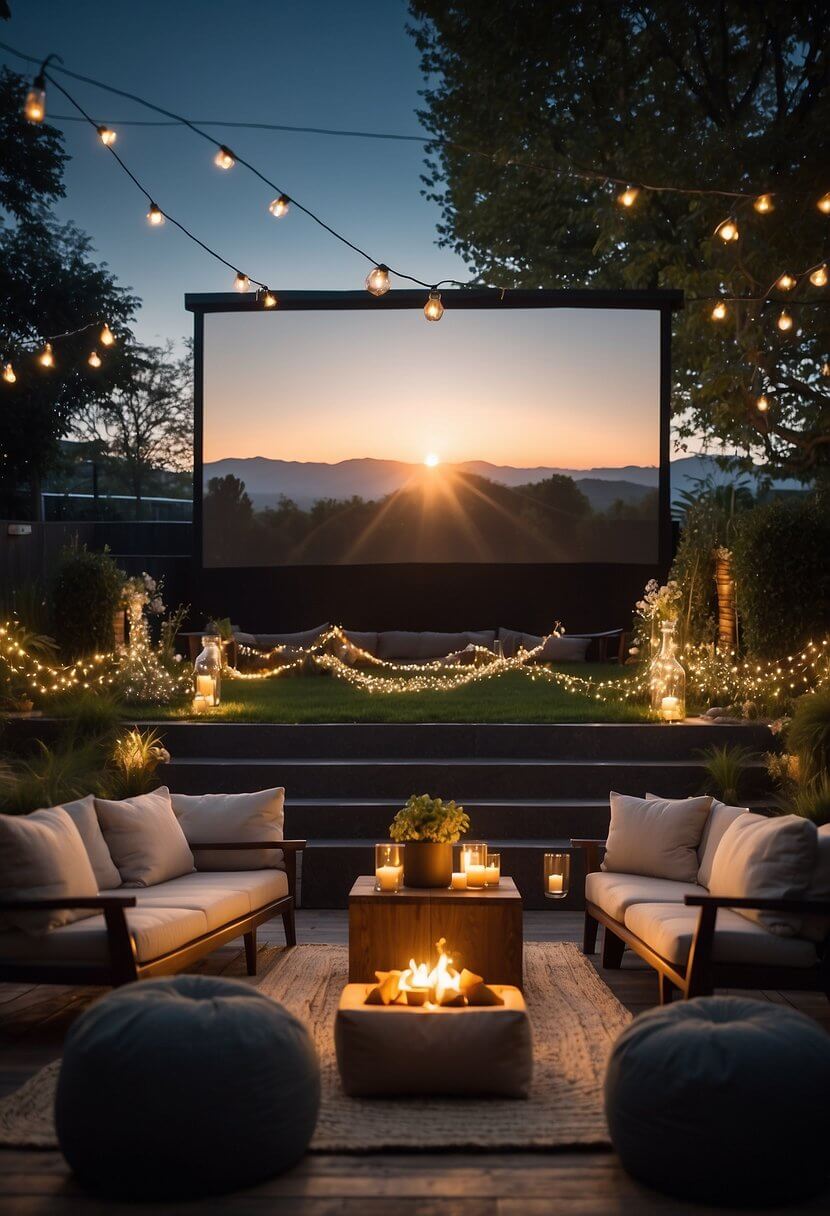
Turn your garden into a magical outdoor cinema for cozy movie nights. Start with a simple setup: an outdoor projector is cost-effective and provides great picture quality.
For seating, think comfort. Use cushions, blankets, and giant pillows to create a cozy vibe. You can also throw in some bean bags for extra seating options.
Arrange your seating in rows for a classic cinema feel, or scatter them around for a relaxed atmosphere. Light up the area with tealights in glass jars for a magical touch.
Don’t forget the snacks! Set up a small table with popcorn, drinks, and other treats to keep everyone happy.
With these touches, your garden can become the perfect spot for movie nights.
14. Use Native Plants
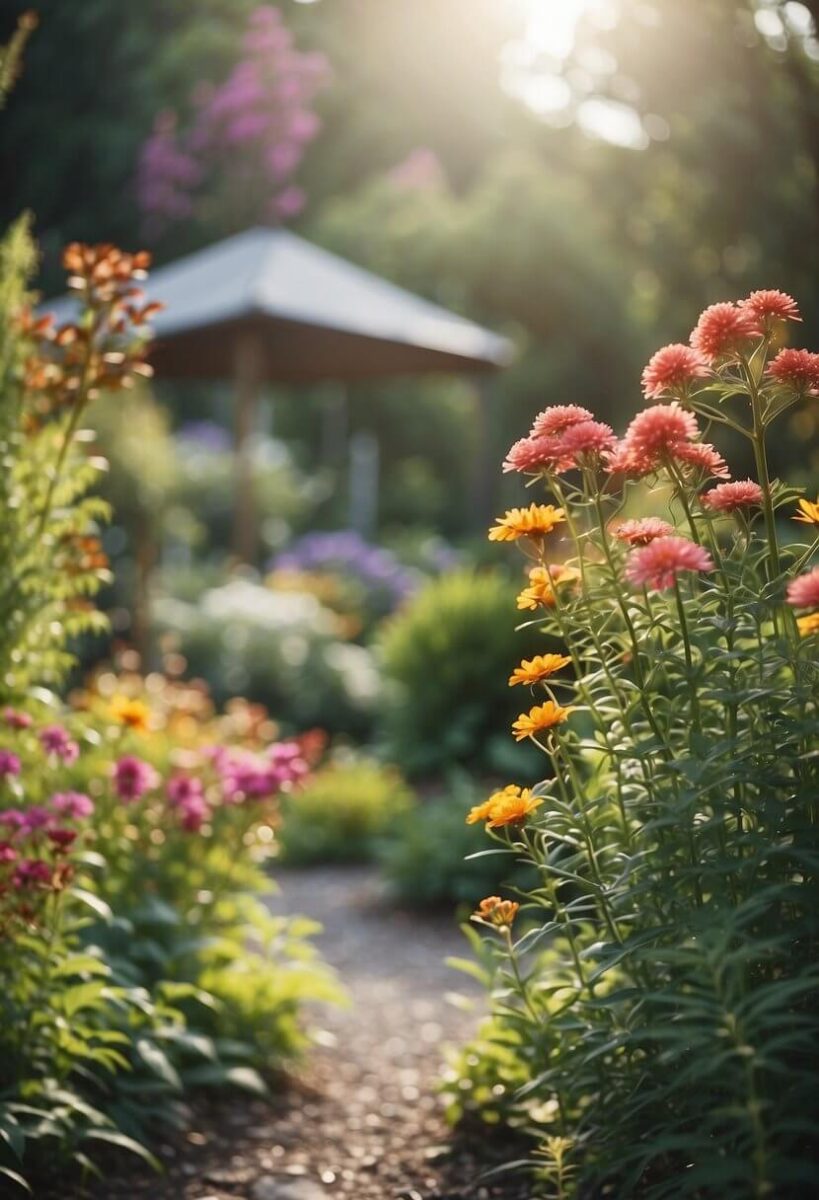
Native plants are a fantastic way to spruce up your garden. They are perfectly adapted to your local climate, so they need less water and fertilizer. This makes them perfect for a budget-friendly garden.
Native plants attract local wildlife. You might see more birds, bees, and butterflies enjoying your garden. It’s like your own mini-ecosystem!
They also require less maintenance, so you won’t spend all your time weeding and pruning. You can sit back and enjoy your garden more.
Benefits of Native Plants:
- Low Maintenance: Less need for water and fertilizers.
- Supports Local Wildlife: Attracts birds, bees, and butterflies.
- Environmentally Friendly: Conserves water and reduces the use of chemicals.
Examples of Native Plants:
- Prickly Pear: Can be grown from seed or a pad.
- Milkweed: Great for attracting butterflies.
- Coneflowers: Vibrant and low-maintenance.
You can save even more by letting volunteer plants grow in your garden. These plants appear naturally, often native to your area.
Using native plants not only makes your garden look lovely but also helps the environment. Lesser demand for water and chemicals is good for you and the planet!
15. DIY Raised Beds
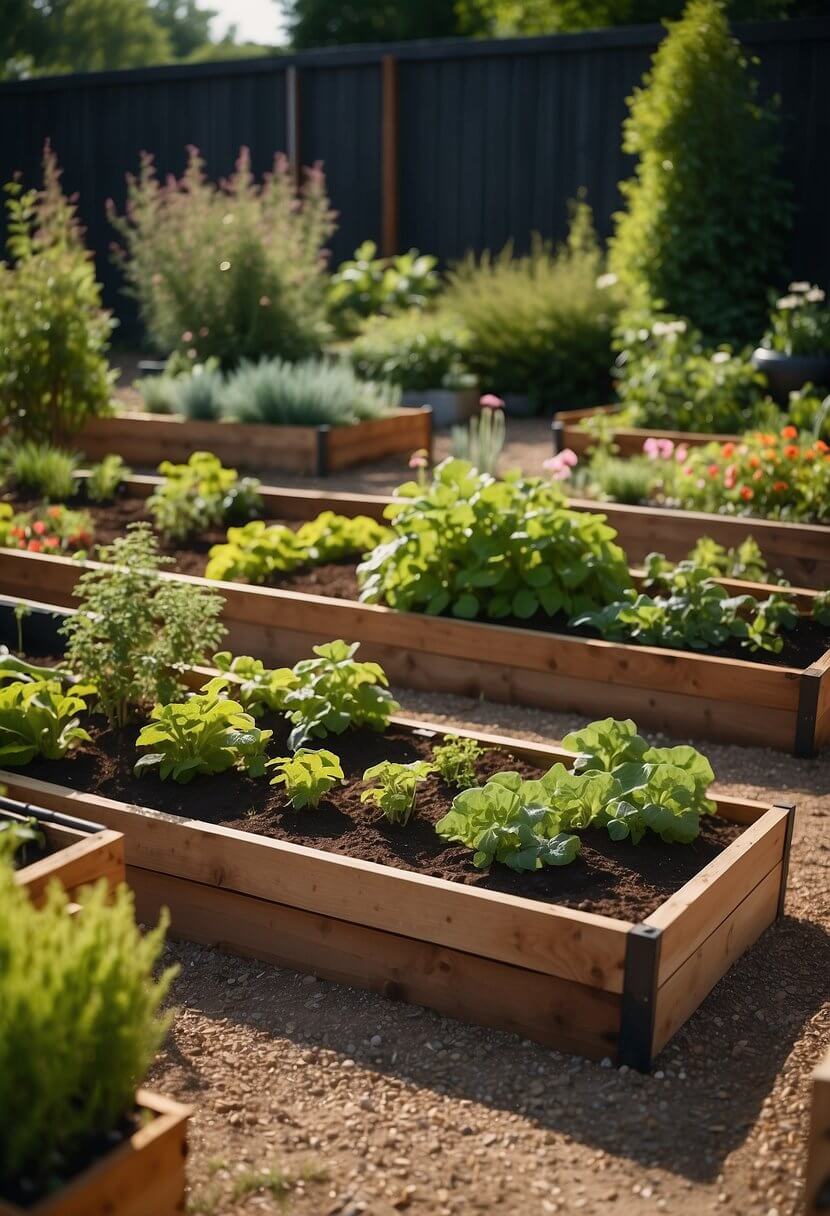
Creating your own raised garden beds is a great way to grow plants without spending much money.
You can use materials like pallets or wood planks to build the frame. These can often be found for free at hardware stores or repurposed from old projects.
Another simple option is using steel bins. These bins, originally for livestock, work well as garden containers. They keep plants contained and are easy to manage.
Wood choices like cedar are excellent because they last long and look great. If you have basic carpentry skills, building a cedar bed is straightforward.
You can also make raised beds using rocks or by weaving branches. This method is free if you have access to natural materials.
To make a branch bed, pound stakes into the ground in a line, then weave branches between them.
Consider adding a built-in trellis to support climbing plants like tomatoes and cucumbers.
This gives your garden a neat and organized look. It also maximizes space by allowing plants to grow vertically.

